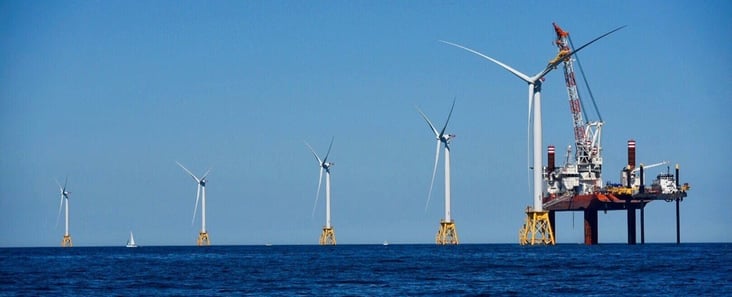This post is one in a series of feature stories on trends shaping advanced energy markets in the U.S. and around the world, drawn from Advanced Energy Now 2017 Market Report, which was prepared for AEE by Navigant Research.

The United States installed its first offshore wind facility in 2016. The 30 MW Block Island project off Rhode Island, developed by Deepwater Wind, now raises the broader question to industry followers and the American public alike: Does Block Island herald the beginning of an offshore wind market in the United States?
If it does, there is a lot of catching up to do, compared to the rest of the world. At the end of 2015, total global offshore wind capacity reached nearly 12,000 MW. A remarkable 3,755 MW of that total came online in 2015, driven largely by Germany.
The Production Tax Credit (PTC) and the Investment Tax Credit (ITC), tax policies that support wind projects, were reinstated in late 2015, and critical new timeline flexibility announced in mid-2016 allows wind projects that began construction or achieve “safe harbor” through a 5% spending on equipment by the end of 2016 to have four years to complete construction and receive 100% tax credit value.
The following three years provide declining tax credit values (80%, 60%, and 40%) if projects begin construction in years 2017, 2018, and 2019, providing a window of policy certainty that will affect the installation of wind projects through 2023. Navigant Research estimates 8.2 GW of wind was installed in the U.S. in 2016, bringing the cumulative total to approximately 84 GW – enough capacity to generate electricity for 20 million homes.
Despite the late start, Navigant Research projects that the United States will develop a modest U.S. offshore wind market by the early 2020s, with multiple projects in the 300 MW or above range. The following are developments driving the U.S. offshore wind industry in the coming years:
- Federal Ocean Leases: More than 16,000 MW in the offshore wind project development pipeline is advancing thanks to 11 offshore wind-site lease auctions offered by the federal Bureau of Ocean Energy Management (BOEM).
- Massachusetts: First-in-the-nation leg-islation was passed in July 2016 requiring utilities to contract for 1,600 MW of offshore wind by 2027. Deepwater, DONG Energy, and OffshoreMW each hold federal leases for tracts off the Massachusetts coast and are expected to compete for these power contracts. DONG has already entered into a partnership with Eversource Energy, with the utility taking a 50% stake in the Bay State Wind project off of Martha’s Vineyard.
- New York: In his 2017 State of the State Address, Governor Andrew Cuomo committed the state to building 2.4 GW of offshore wind by 2030. Long Island Power Authority has contracted with Deepwater for a 15-turbine, 90 MW project at a cost of $740 million. Statoil outbid NYSERDA in a BOEM auction, securing an offshore lease for another project at the record price of $42 million.
- Carper-Collins ITC Bill: This bill in the U.S. Senate would extend the 30% investment tax credit (ITC) to up to 3 GW of offshore wind. Due to falling prices, estimates have reduced the cost of the bill from $3.5 billion to $535 million, making it more attractive to lawmakers.
- S. DOE Demonstration Projects: The DOE has awarded two Advanced Technology Demonstration Projects in Ohio and Maine for the Lake Erie Energy Development Corporation’s Icebreaker and the University of Maine’s New England Aqua Ventus I projects, respectively. Both are eligible for up to $40 million each, contingent on reaching milestones and con-gressional appropriations.
U.S. offshore wind can expect costs to fall over the next decade, making it easier to capture the abundant potential in the United States. A new cost analysis by the National Renewable Energy Laboratory shows scenarios for cost reductions below $100/MWh by 2025, making this resource competitive in some regions of the country, including the Northeast, where retail electricity prices are high. Results in recent European contract auctions support this assessment. DONG won a contract for 700 MW at €72.70/MWh (~$80.52/MWh) and Vattenfall captured a Danish near-shore tender at €63.8/MWh (~$71.15/MWh).
With a technical potential of 2,058 GW accessible in U.S. waters, the scale of offshore wind development is potentially massive. That potential is nearly double the total electric generation capacity of the United States in 2015. A DOE analysis expects the United States to could develop as much as 86 GW of offshore wind by 2050. While it’s a small fraction of the potential, it means offshore wind could be a U.S. reality before long.
Find out more about this year's advanced energy trends and the full size of the advanced energy market by downloading Advanced Energy Now 2017 Market Report, available for free at the link below:
